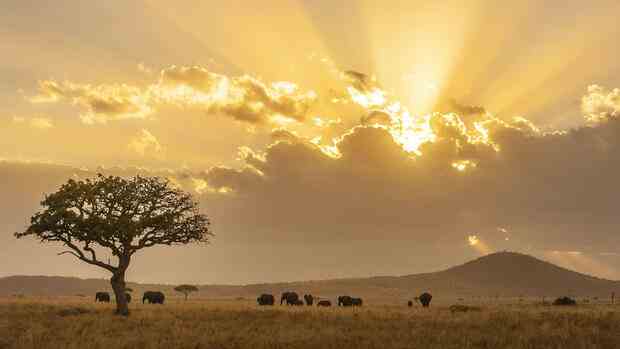Berlin Negotiations for a global agreement to protect species and biodiversity begin this Wednesday at the World Conservation Conference in Montreal, Canada.
While the climate crisis is now a global issue, the debates about the biodiversity crisis have so far been rather marginal. Wrongly, according to economists like Jörg Rocholl. “The protection and restoration of biological diversity is just as important as the fight against the rise in temperature,” said the President of the international business university ESMT Berlin to the Handelsblatt.
The consequences of a destroyed nature are considerable – for society and the economy alike. The livelihoods of many people are threatened because, for example, protection against storm surges, heavy rain, heat and drought is dwindling. In addition, the damage to nature undermines the basis of economic activity.
“Biodiversity is the decisive prerequisite for the global economic system,” said Rocholl, who recently called for the so-called “Frankfurt Declaration” together with other scientists and non-governmental organizations to end economic activity against nature. The destruction of ecosystems is a problem “of the utmost importance”, explains the ESMT President.
Top jobs of the day
Find the best jobs now and
be notified by email.
Federal Environment Minister Steffi Lemke also emphasized man’s dependence on nature: “We humans are dependent on intact nature, on ecosystem services,” said the Green politician on Tuesday. “Half of the global gross domestic product depends on the services of nature.”
Difficult negotiations expected
The Montreal conference, also known as CBD COP15, was originally scheduled to take place in China, but was postponed several times due to the corona pandemic. This overview shows what it is about and what Germany’s goals are at the almost two-week conference.
What does CBD COP15 stand for?
CBD stands for Convention on Biological Diversity, COP for Conference of the Parties – the contracting parties to the United Nations Convention on Biological Diversity, a total of 196 countries, meet here. This year’s 15th summit is seen by many as the last chance to stop the decline of nature. The Environment Minister expects difficult negotiations: “There have certainly been more favorable times for multilateral agreements on environmental protection and nature conservation.”
what are the problems
Biological diversity secures the basis of life for people. Healthy soil, insects and diverse plants are prerequisites for functioning agriculture and for feeding the world population. Nature provides many ingredients for medicines. Forests and moors bind carbon dioxide from the atmosphere and store it for the long term.
However, people are encroaching further and further into the habitats of animals and plants and are destroying them. Ultimately, Montreal is about the key question of how to reconcile nature conservation and use, also to limit the risk of pandemics.
>> Read here: Environmental and climate protection also helps against pandemics
What does the loss of biological diversity mean in concrete terms?
About a million animal and plant species are threatened with extinction. In Germany, for example, the number of insect species has been decreasing for years, for example among wild bees. This means that important services are lost, such as pollination of plants. Globally, 75 percent of food plant species depend on animal pollination. Plants pollinated by bees contribute about a third of human nutrition. But insects also have other functions. They serve as fodder for other species, break down organic matter, are biological pest controllers, keep water bodies clean and soil fertile.
Is there a value for biodiversity?
Scientists estimate the total economic value of the services provided by an intact nature at 170 to 190 trillion US dollars per year. “The current economic model makes use of these services of nature without payment,” says the “Frankfurt Declaration”. The result: overexploitation and destruction of natural resources “and thus our most important basis of life”.
Central point of negotiation: the 30×30 protected area target
What exactly is Montreal aiming to achieve?
The demand for an agreement that commits the states to the goal of placing at least 30 percent of the area on land and in the sea under protection by 2030 is central. This 30×30 target would roughly double the protected area on land and quadruple it at sea. For Lemke, that’s not all: every agreement must be “measurable and binding,” she said. “Just setting goals will not be enough.”
Plants pollinated by bees contribute about a third of human nutrition.
(Photo: IMAGO/photo2000)
Scientists call for a “binding, global agreement of historic proportions to protect nature”. The climate crisis is scientifically much better researched than the crisis of biodiversity loss, says ESMT President Rocholl. For example, the question arises as to how the loss of biodiversity can be priced, similar to climate-damaging CO2 emissions. “So far, there has been a lack of consensus for such an assessment to motivate companies to take more action.”
What role does Germany play?
As the fourth largest economy in the world, Germany has an enormous “biodiversity footprint”, according to the “Frankfurt Declaration”. “The global value chains of German companies have a significant impact on nature and often contribute to its destruction.”
The alliance expects companies to report on biodiversity as a concrete result of the conference. It is said that politicians must ensure that companies and their financial institutions measure their biodiversity impacts and dependencies. In addition, they should report regularly on how negative effects can be reduced and positive effects made possible along the value chain.
What is Germany doing to protect biodiversity?
The Ministry of the Environment has set itself the goal of strengthening natural climate protection in Germany. Specifically, it is about wetting moors so that they can be used as carbon stores, or renaturing floodplains. Funds of four billion euros are to be made available for this between 2022 and 2026.
Between 2017 and 2021, Germany made available an average of around 750 million euros a year for international measures to preserve biological diversity. From 2025 at the latest, 1.5 billion euros are to flow annually.
More: Biodiversity and its price
